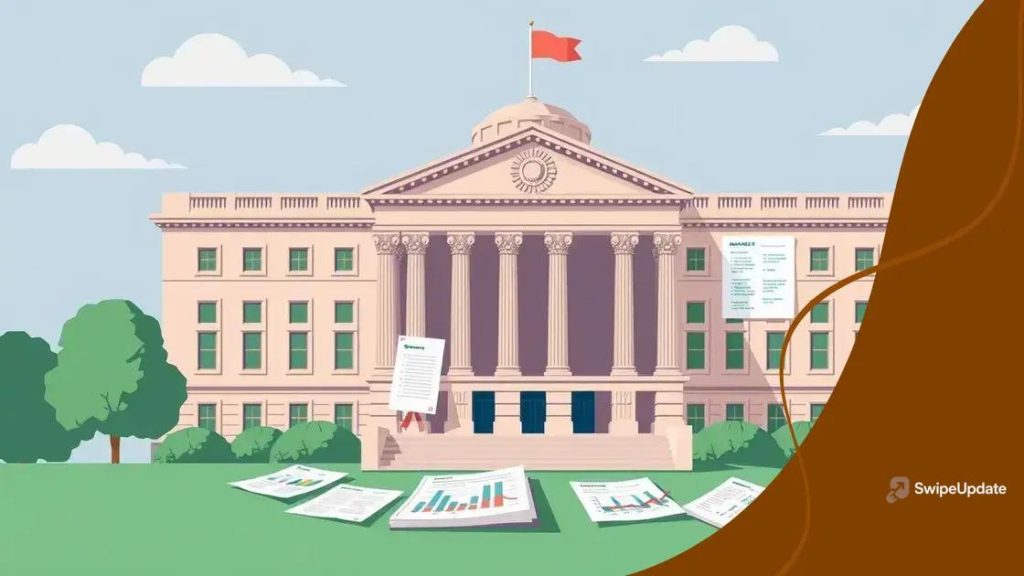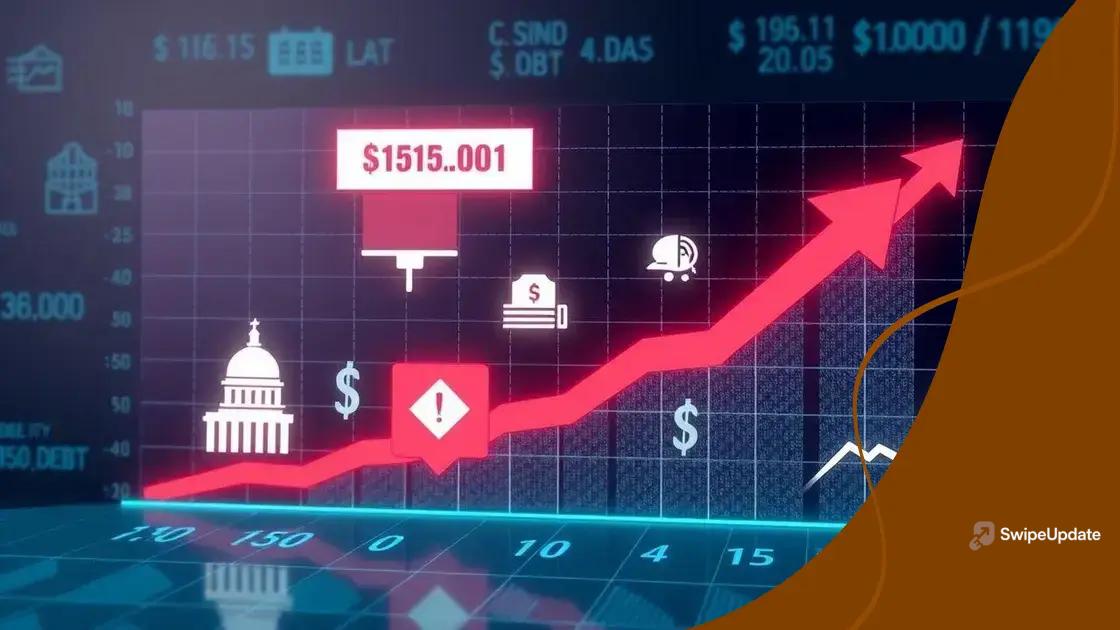The ongoing discussion about the national debt: what you need to know

The national debt significantly affects citizens’ lives by resulting in higher taxes, reduced government services, increased interest rates, and influencing public confidence in the economy.
The ongoing discussion about the national debt touches on critical aspects of our economy that impact everyone. As debates intensify, you might wonder how it really affects your daily life and what it means for the future.
Understanding the national debt and its impact
Understanding the national debt is crucial for grasping how it impacts our economy and society. National debt refers to the total amount of money that a country’s government has borrowed. It is important to dig deeper into its implications and effects on various aspects of our lives.
What contributes to the national debt?
Several factors contribute to the accumulation of national debt. These include government spending on programs and services as well as the need to finance these expenditures through borrowing. Here are key contributors:
- Increased government spending
- Tax cuts reducing revenue
- Economic downturns
- Interest on existing debt
These factors create a cycle where borrowing may seem necessary, but could lead to long-term economic problems.
How does national debt affect you?
The implications of national debt are far-reaching. For instance, it can lead to higher taxes as governments seek to repay borrowed funds. Additionally, high national debt may affect national investments and reduce funding for essential services, such as education and healthcare. Understanding these implications helps citizens recognize the priorities and constraints their governments face.
Moreover, national debt can influence interest rates. When the government borrows extensively, it may drive up rates, making loans and mortgages more expensive for individuals. This creates a ripple effect impacting consumers directly, making it more challenging for families to plan financially.
As we explore further, it’s essential to take into account how the national debt is perceived in various contexts. The debate over whether it is manageable or alarming can vary depending on economic perspectives.
Individuals often wonder whether reducing the national debt is feasible or realistic without compromising critical services. Exploring these questions provides a clearer picture of the landscape of national debt.
Historical context of national debt in the US
The historical context of national debt in the US is essential for understanding how it has evolved over time. From the founding of the nation to the present day, the way we handle debt has changed significantly.
The early years of national debt
In the late 18th century, the United States faced significant financial challenges. After gaining independence, the young nation had considerable debts from the Revolutionary War. The government adopted various strategies to manage these debts, including issuing bonds. This laid the groundwork for how national debt would be perceived and managed in the future.
- The federal government assumed state debts
- The establishment of the First Bank of the United States
- Creating a system to manage and repay the debt
These steps were vital in establishing credibility and a stronger financial foundation.
Significant events impacting national debt
Over the years, various events have shaped the trajectory of the national debt. The Civil War led to substantial borrowing to finance military expenses. This marked a turning point, as the federal government expanded its role in economic matters. The Great Depression in the 1930s prompted increased government spending to stimulate the economy, further adding to the national debt.
Additionally, wars like World War II necessitated extensive borrowing, pushing the national debt to unprecedented levels. As we moved into the late 20th century, economic policies and changes in attitude toward debt evolved, often reflecting political and social priorities.
The actions taken during these critical times continue to influence the ways we view and manage national debt today. The lessons drawn from history inform current debates surrounding the sustainability and impact of national debt.
Overall, examining the historical context of national debt in the US reveals how past events and decisions shape our present economic landscape.
Current trends and figures of national debt

Current trends and figures of national debt reveal a complex financial landscape that affects everyone. It is essential to understand what these trends mean for the economy and citizens alike.
Recent statistics on national debt
As of recent reports, the national debt has reached historically high levels. Figures indicate that the total debt now exceeds $30 trillion, a significant increase from previous years. This rise can be attributed to several factors, including:
- Increased government spending due to economic stimulus
- Ongoing costs related to healthcare and social security
- The impact of the COVID-19 pandemic on the economy
- Interest accruing on existing debt
These statistics provide insight into the financial direction of the nation.
Impact of rising national debt
The implications of rising national debt are multifaceted. For one, a higher debt level can lead to increased interest rates, as the government may need to borrow more frequently. This can make loans more expensive for consumers and businesses alike. Also, there is concern about how the servicing of this debt will affect future budgets.
Many experts argue that a sustainable level of national debt must be carefully monitored. With ongoing discussions in Congress, policymakers are considering various strategies to address the debt. Some of these strategies include:
- Potential tax reforms
- Spending cuts in specific areas
- Improving economic growth to increase revenues
As these trends develop, they directly impact both the economy and the lives of everyday citizens. Awareness of how national debt trends affect your financial future is crucial. Keeping informed about the figures and their implications helps you understand broader economic policies and debates.
Possible solutions to manage the national debt
Many discussions have arisen around possible solutions to manage the national debt. Addressing this issue requires a multifaceted approach that balances economic growth and responsible spending.
Increasing revenue through tax reforms
One potential solution is to reform the tax system. By closing loopholes and implementing fair tax policies, the government can increase revenue without overburdening the average citizen. Some ways to enhance revenue include:
- Implementing a progressive tax system
- Improving tax collection efficiency
- Eliminating unnecessary tax breaks
Reforming taxes can generate funds needed to lower the debt effectively.
Reducing government spending
Another way to manage national debt is by reducing unnecessary government spending. Taking a hard look at budget priorities allows for cuts in less impactful areas while protecting essential services. Areas to consider for spending cuts are:
- Streamlining government programs
- Reducing waste and inefficiencies
- Evaluating unnecessary military expenditures
These steps can help reallocate resources more effectively.
Also, economic growth plays a crucial role in managing the national debt. By boosting the economy, the government can increase tax revenues. Encouraging investments in infrastructure and innovation leads to job creation and a more robust economic environment. This, in turn, helps lower the debt-to-GDP ratio.
Moreover, proactive measures such as improving financial literacy among citizens can enhance understanding of the national debt. When individuals are informed, they can participate in economic discussions and advocate for better policies.
Finding the right mix of solutions to manage national debt is vital for future financial stability. Continuous evaluation and adaptation of these strategies can lead to a healthier economy and reduced burden of debt.
How the national debt affects citizens’ lives
The national debt has a direct impact on the everyday lives of citizens. Understanding how it affects various aspects of life is important for making informed choices.
Economic implications
One of the most significant ways the national debt impacts citizens is through economic implications. High levels of debt can lead to increased taxes as the government seeks new revenues to pay off what it owes. This can strain household budgets and limit disposable income.
- Potential increase in payroll taxes
- Higher sales tax rates
- Taxes on investments
These taxes can affect how much money families have for savings and spending, altering their quality of life.
Influences on government services
Another critical effect is the impact on government services. When a significant portion of the budget goes toward debt servicing, fewer resources may be available for essential services like education, healthcare, and infrastructure. Citizens may face:
- Longer waiting times in hospitals
- Reduce funding for schools
- Underfunded public transportation systems
This can lead to a decline in the overall quality of life, making it harder for citizens to thrive. Citizens who depend on these services may feel the pinch directly.
Additionally, the national debt can influence interest rates. When the government borrows extensively, it may raise rates to attract investors. This can result in higher costs for loans, affecting mortgages and student loans. Citizens looking to purchase homes or finance education may find themselves paying more.
Finally, public perception of the national debt can also affect citizen confidence in the economy. Concerns about debt may lead to reduced consumer spending, as people may prioritize saving over spending. This can create a cycle of negative economic impact, further complicating debt management efforts.
FAQ – Frequently Asked Questions about National Debt and Its Impact
How does national debt affect taxes for citizens?
National debt can lead to increased taxes as the government seeks to generate revenue to repay what it owes, potentially impacting disposable income.
What services might be affected by rising national debt?
Services like education, healthcare, and infrastructure may face budget cuts as more funds go towards servicing the national debt.
Can national debt influence interest rates?
Yes, higher national debt levels may lead to increased interest rates for loans and mortgages, making borrowing more expensive.
How can citizens advocate for better debt management policies?
Citizens can stay informed about national debt issues, participate in discussions, and vote for policies that promote financial responsibility and economic growth.
